Durability of Mortar Containing Coal Bottom Ash as a Partial Cementitious Resource
Abstract
:1. Introduction
2. Materials and Methods
2.1. Mixtures Proportion
2.2. Mixtures Proportion
2.3. Test Procedures
2.3.1. Durability Parameters
2.3.2. Cement Material Degradation Phenomena
- Carbonation
- Ammonium nitrate leaching
3. Results and Discussion
3.1. Carbonation
3.1.1. Carbonation Depth
3.1.2. Poral Distribution by Nitrogen Adsorption Desorption
3.1.3. Gas Permeability Coefficient
3.1.4. Water-Accessible Porosity
3.1.5. Capillary Absorption
3.1.6. Electrical Resistivity
3.2. Ammonium Nitrate Leaching
3.2.1. Leaching Depth
3.2.2. Poral Distribution by Nitrogen Adsorption Desorption
3.2.3. Gas Permeability Coefficient
3.2.4. Water-Accessible Porosity
3.2.5. Capillary Absorption
3.2.6. Electrical Resistivity
3.3. Chloride Ions Diffusion
4. Conclusions
Author Contributions
Funding
Acknowledgments
Conflicts of Interest
References
- Emad, B.; Gholamreza, Z.; Ezzatollah, S.; Alireza, B. Global strategies and potentials to curb CO2 emissions in cement industry. J. Clean. Prod. 2013, 51, 142–161. [Google Scholar]
- Mokhtaria, B.; Fatiha, K.A.; Abdelaziz, S. Durabilité des mortiers à base de pouzzolane naturelle et de pouzzolane artificielle. Rev. Nat. Technol. 2009, 1, 63–73. [Google Scholar]
- Rashad, A. Metakaolin as cementitious material: History, scours, production and composition – A comprehensive overview. Constr. Build. Mater 2013, 41, 303–318. [Google Scholar] [CrossRef]
- Hosseini, M.M.; Shao, Y.; Whalen, J.K. Biocement production from silicon-rich plant residues: Perspectives and future potential in Canada. Biosyst. Eng. 2011, 110, 351–362. [Google Scholar] [CrossRef]
- Ayrinhac, F. Valorisation des Cendres Volantes de Chaudière à Lit Fluidisé Circulant dans la Filière du Génie Civil. Ph.D. Thesis, Institut National des Sciences Appliquées de Toulouse, Toulouse, France, June 2005. [Google Scholar]
- Cheriaf, M.; Rocha, J.; Pera, J. Pozzolanic properties of pulverized coal combustion bottom ash. Cem. Concr. Res. 1999, 29, 1387–1391. [Google Scholar] [CrossRef]
- Haldun, K.; Mine, K. Usage of coal combustion bottom ash in concrete mixture. Constr. Build. Mater. 2007, 1922–1928. [Google Scholar] [CrossRef]
- Kula, I.; Olgun, A.; Erdogan, Y.; Sevinç, V. Effects of colemanite waste, cool bottom ash, and fly ash on the properties of cement. Cem. Concr. Res. 2001, 31, 491–494. [Google Scholar] [CrossRef]
- Ramezanianpour, A.; Jovein, H.B. Influence of metakaolin as supplementary cementing material on strength and durability of concretes. Constr. Build. Mater. 2012, 30, 470–479. [Google Scholar] [CrossRef]
- Wongkeo, W.; Thongsanitgarn, P.; Chaipanich, A. Compressive strength and drying shrinkage of fly ash-bottom ash-silica fume multi-blended cement mortars. Mater. Des. 2012, 36, 655–662. [Google Scholar] [CrossRef]
- Savadogo, N. Élaboration et Caractérisation d’un Éco-ciment à Base de Poudre de Mâchefer de Charbon. Ph.D. Thesis, Institut National des Sciences Appliquées de Rennes, Rennes, France, 2017. [Google Scholar]
- Savadogo, N.; Messan, A.; Hannawi, K.; Tsobnang, F.; Prince, A.W. Durabilité d’un ciment composé à base de mâchefer de Tefereyre (Niger): Absorption capillaire, porosité accessible à l’eau et attaque acide. J. Mater. Eng. Struct. 2015, 2, 213–223. [Google Scholar]
- Argiz, C.; Moragues, A.; Menéndez, E. Use of ground coal bottom ash as cement constituent in concretes exposed to chloride environments. J. Clean. Prod. 2018, 170, 25–33. [Google Scholar] [CrossRef]
- Thiery, M.; Villain, G.; Platret, G. Effect of carbonation on density, microstructure and liquid water saturation of concrete. In Proceedings of the 9th Engineering Conference on Advances in Cement and Concrete, Copper Mountain, CO, USA, 10–14 August 2003; Lange, D.A., Scrivener, K.L., Marchand, J., Eds.; Engineering Conferences International (E.C.I.): New York, NY, USA, 2003; pp. 481–490. [Google Scholar]
- Ngala, V.; Page, C. Effects of carbonation on pore structure and diffusional properties of hydrated cement pastes. Cem. Concr. Res. 1997, 27, 995–1007. [Google Scholar] [CrossRef]
- Metalssi, O.O.; Aït-Mokhtar, A.; Turcry, P.; Ruot, B. Consequences of carbonation on microstructure and drying shrinkage of a mortar with cellulose ether. Constr. Build. Mater. 2012, 34, 218–225. [Google Scholar] [CrossRef]
- Miragliotta, R. Modélisation des Processus Physico-Chimiques de la Carbonatation des Bétons Préfabriqués—Prise en Compte des Effets de Paroi. Ph.D. Thesis, l’Université de la Rochelle, La Rochelle, France, 2000. [Google Scholar]
- Thiery, M. Modelling of Atmospheric Carbonation of Cement Based Materials Considering the Kinetic Effects and Modifications of the Microstructure. Ph.D. Thesis, L’école Nationale des Ponts et Chausses, Champs-sur-Marne, France, 2005. [Google Scholar]
- Darkhmouche, F. Carbonatation des Béton Adjuvantés à Base de Ressources Locales Algériennes. Ph.D. Thesis, Université d’Orléans, Orléans, France, 2009. [Google Scholar]
- Neville, A. Propriétés des Bétons; Eyrolles: Paris, France, 2000; p. 806. ISBN 10: 2-212-01320-5. [Google Scholar]
- Khan, M.I.; Lynsdale, C. Strength, permeability, and carbonation of high-performance concrete. Cem. Concr. Res. 2002, 32, 123–131. [Google Scholar] [CrossRef]
- Atis, C.D. Accelerated carbonation and testing of concrete made with fly ash. Constr. Build. Mater. 2003, 17, 147–152. [Google Scholar] [CrossRef]
- Kaid, N.; Cyr, M.; Julien, S.; Khelafi, H. Durability of concrete containing a natural pozzolan as defined by a performance-based approach. Constr. Build. Mater. 2009, 23, 3457–3467. [Google Scholar] [CrossRef]
- Andrade, C.; Bujak, R. Effects of some mineral additions to Portland cement on reinforcement corrosion. Cem. Concr. Res. 2013, 53, 59–67. [Google Scholar] [CrossRef]
- Byfors, K. Influence of silica fume and fly ash on chloride diffusion and pH values in cement paste. Cem. Concr. Res. 1987, 17, 115–130. [Google Scholar] [CrossRef]
- Elahi, A.; Basheer, P.; Nanukuttan, S.; Khan, Q. Mechanical and durability properties of high perfomance concretes containing supplementary materials. Constr. Build. Mater. 2010, 24, 292–299. [Google Scholar] [CrossRef]
- ASTM International. Norme, ASTM Standard, C618-08a: Standard Specification for Coal Fly Ash and Raw or Calcined Natural Pozzolan for Use in Concrete; Annual Book of ASTM Standards; ASTM International: West Conshohocken, PA, USA, 2008. [Google Scholar]
- Directive 1999/31/CE. Directive du conseil concernant la mise en décharge des déchets. J. Officiel Communautés Européennes 1999. Available online: aida.ineris.fr.
- AFNOR. NF EN 933-8+A1: Essais pour déterminer les caractéristiques géométriques des granulats-Partie 8: évaluation des fines-Équivalent de sable, Juillet 2015; AFNOR: Saint-Denis, France, 2016; Available online: www.boutique.afnor.org (accessed on 30 September 2020).
- AFNOR. EN 196-1: Méthodes D’essais des Ciments-Partie 1: Détermination des Résistances Mécaniques; AFNOR: Saint-Denis, France, 2016; Available online: www.boutique.afnor.org (accessed on 30 September 2020).
- Barrett, E.P.; Joyner, L.G.; Halenda, P.P. The Determination of Pore Volume and Area Distributions in Porous Substances. I. Computations from Nitrogen Isotherms. J. Am. Chem. Soc. 1951, 73, 373–380. [Google Scholar] [CrossRef]
- AFPC-AFREM: Durabilité des bétons « Méthodes recommandées pour la mesure des grandeurs associées à la durabilité » Compte-rendu des journées techniques. In Proceedings of the Technical AFCP/AFREM Days on Concrete Durability, “Recommended methods for measuring of durability parameters”, Toulouse France, 11–12 December 1997; Laboratoire Matériaux et Durabilité des Constructions: Toulouse, France, 1997.
- Baroghel-Bouny, V.; Belin, P.; Maultzsch, M.; Henry, D. AgNO3 spray tests: Advantages, weaknesses, and various applications to quantify chloride ingress into concrete. Part 2: Non-steady-state migration tests and chloride diffusion coefficients. Mater. Struct. 2007, 40, 783–799. [Google Scholar] [CrossRef]
- Bellégo, C.L.; Gérard, B.; Pijaudier Cabot, G. Mechanical Analysis of Concrete Structures Submitted to an Aggressive Water. Fracture Mechanics of Concrete Structures; Swets and Zeitlinger: Lisse, The Netherlands, 2001; pp. 239–246. [Google Scholar]
- Auroy, M. Impact de la Carbonatation sur les Propriétés de Transport d’Eau des Matériaux Cimentaires. Ph.D. Thesis, Ecole Nationale des Ponts et Chaussées, Champs-sur-Marne, France, 2014. [Google Scholar]
- Eitel, W. Silicate Science: Ceramics and Hydraulic Binders; Academic Press: New York, NY, USA, 1966; Volume 5. [Google Scholar]
- Adenot, F.; Buil, M. Modelling of the corrosion of the cement paste by deionized water. Cem. Concr. Res. 1992, 22, 489–496. [Google Scholar] [CrossRef]
- Carde, C. Caractérisation et Modélisation de l’Altération des Propriétés Mécaniques dus à la Lixiviation des Matériaux Cimentaires. Ph. D. Thesis, INSA Toulouse, Toulouse, France, 1996. [Google Scholar]
- Carde, C.; François, R. Effect of the leaching of calcium hydroxide from cement paste on mechanical and physical properties. Cem. Concr. Res. 1997, 27, 539–550. [Google Scholar] [CrossRef]
- Gaitero, J.; Campillo, I.; Guerrero, A. Reduction of the calcium leaching rate of cement paste by addition of silica nanoparticles. Cem. Concr. Res. 2008, 38, 1112–1118. [Google Scholar] [CrossRef] [Green Version]
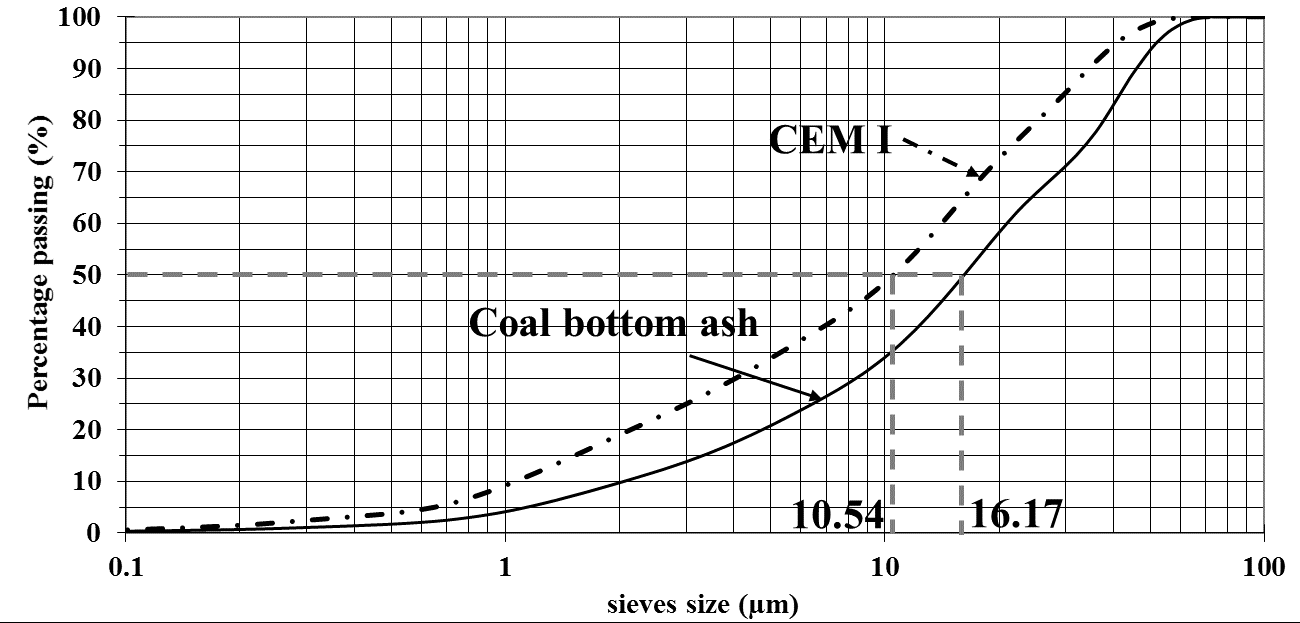



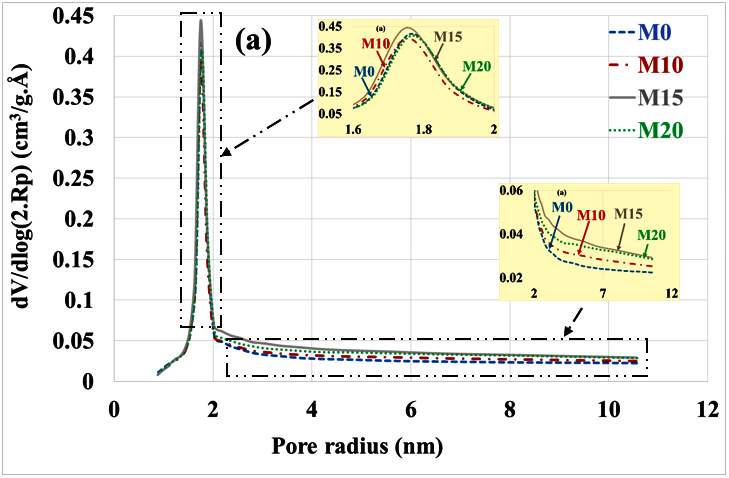
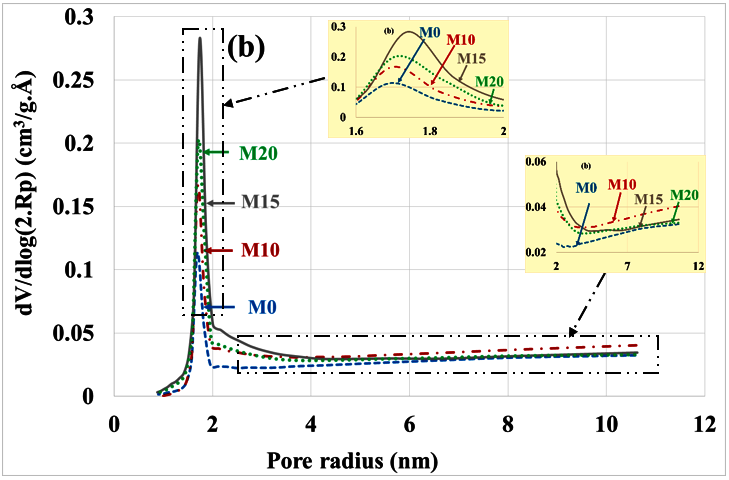
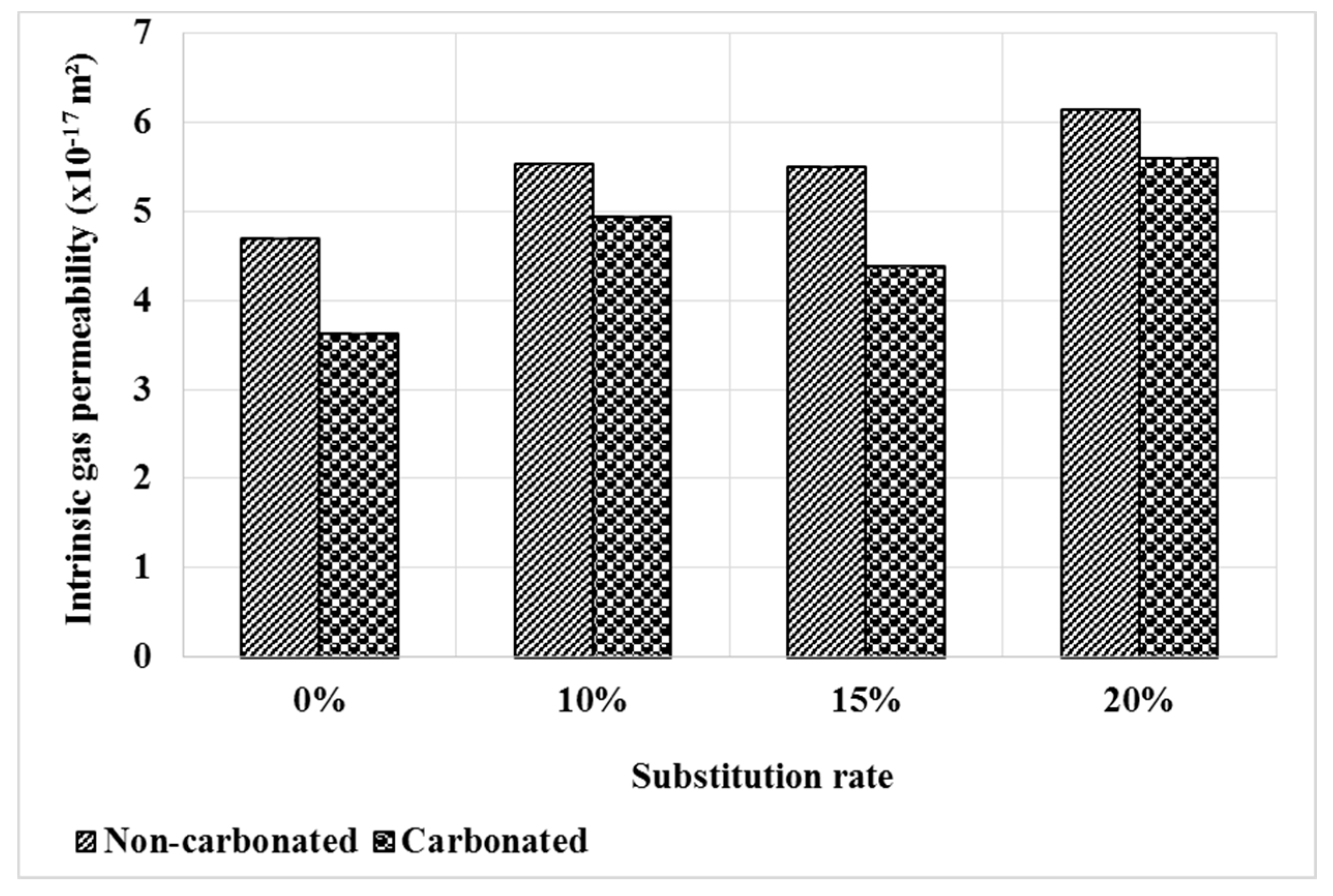
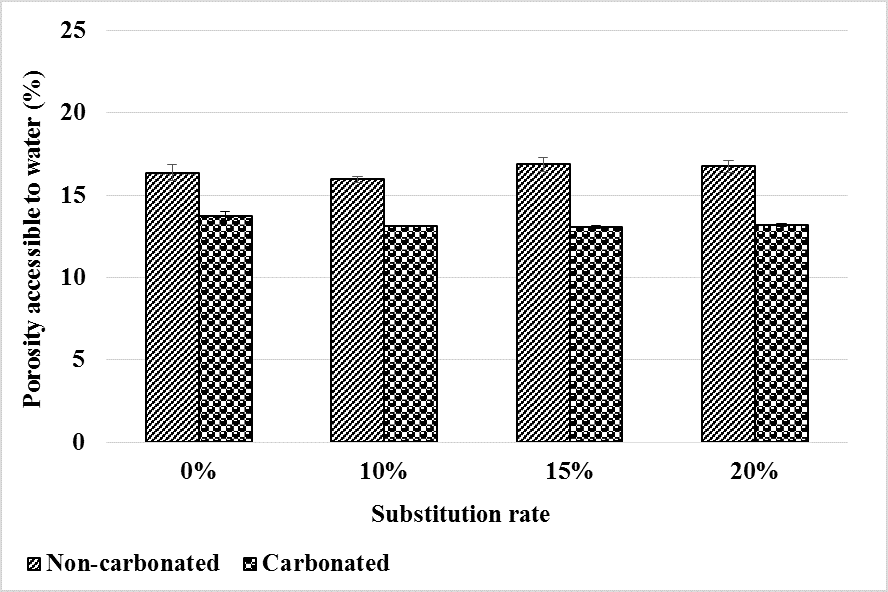




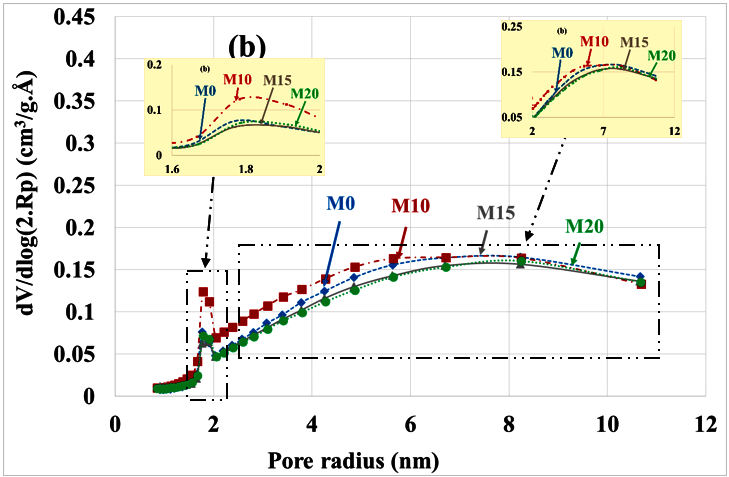

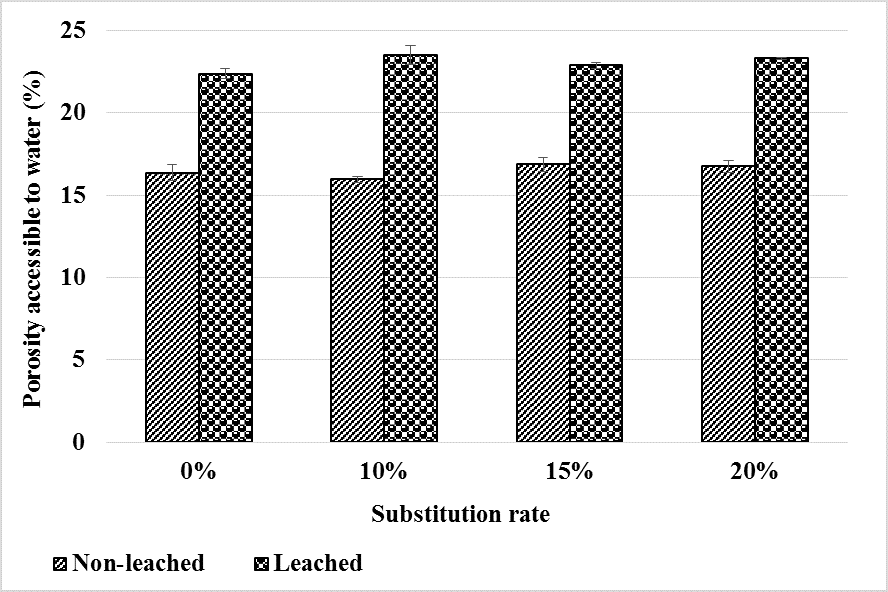


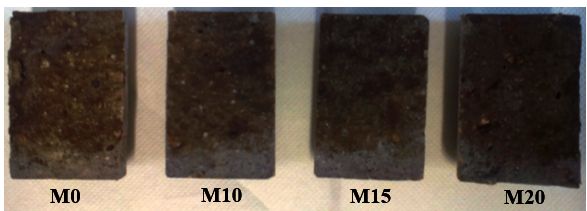
| CEM I | Coal Bottom Ash | |
|---|---|---|
| Chemical composition (% by weight) | ||
| SiO2 | 18.6 | 53.2 |
| CaO | 59.6 | 0.41 |
| Al2O3 | 4.73 | 22.2 |
| Fe2O3 | 3.11 | 4.36 |
| K2O | 0.26 | 1.90 |
| Na2O | 0.10 | 0.22 |
| MgO | 2.57 | 0.56 |
| Mn2O3 | 0.085 | 0.012 |
| TiO2 | 0.24 | 1.67 |
| Cl | 0.03 | 0.01 |
| SO3 | 2.62 | 0.30 |
| SrO | 0.024 | 0.013 |
| P2O5 | 0.47 | 0.042 |
| Loss on ignition | 7.5 | 15.0 |
| Physical characteristics | ||
| D50 (µm) | 10.54 | 16.17 |
| Specific density (t/m3) | 3.10 | 2.31 |
| Apparent density (t/m3) | 1.06 | 0.77 |
| BET specific surface area (m2/g) | 1.47 | 3.67 |
| Blaine specific surface area (cm2/g) | 3565 | 4109 |
| Code | Bottom Ash Powder Rate (%) | Constituent Mass (kg/m3) | ||||
|---|---|---|---|---|---|---|
| Binder | Bottom Ash | Sand | Water | Adjuvant | ||
| M0 | 0 | 292.2 | 0 | 876 | 145 | 5.8 |
| M10 | 10 | 260.3 | 29 | 876 | 145 | 5.8 |
| M15 | 15 | 244.6 | 43.2 | 876 | 145 | 5.8 |
| M20 | 20 | 229 | 57.3 | 876 | 145 | 5.8 |
| Noncarbonated | Carbonated | |||||||
|---|---|---|---|---|---|---|---|---|
| Micropores | Mesopores | Micropores | Mesopores | |||||
| Volume cm3/g·Å | Rm (nm) | Volume cm3/g·Å | Rm (nm) | Volume cm3/g·Å | Rm (nm) | Volume cm3/g·Å | Rm (nm) | |
| M0 | 0.96 | 1.63 | 0.46 | 3.45 | 0.26 | 1.67 | 0.33 | 4.28 |
| M10 | 0.90 | 1.62 | 0.51 | 3.51 | 0.35 | 1.71 | 0.44 | 4.10 |
| M15 | 1.00 | 1.63 | 0.63 | 3.48 | 0.60 | 1.66 | 0.53 | 3.57 |
| M20 | 0.95 | 1.64 | 0.57 | 3.57 | 0.50 | 1.67 | 0.42 | 3.95 |
| Nonleached | Leached | |||||||
|---|---|---|---|---|---|---|---|---|
| Micropores | Mesopores | Micropores | Mesopores | |||||
| Volume cm3/g·Å | Rm (nm) | Volume cm3/g·Å | Rm (nm) | Volume cm3/g·Å | Rm (nm) | Volume cm3/g·Å | Rm (nm) | |
| M0 | 0.96 | 1.63 | 0.46 | 3.45 | 0.26 | 1.58 | 1.49 | 4.68 |
| M10 | 0.90 | 1.62 | 0.51 | 3.51 | 0.42 | 1.61 | 1.68 | 4.42 |
| M15 | 1.00 | 1.63 | 0.63 | 3.48 | 0.26 | 1.52 | 1.41 | 4.67 |
| M20 | 0.95 | 1.64 | 0.57 | 3.57 | 0.28 | 1.54 | 1.39 | 4.71 |
| Substitution Rate (%) | Penetration Depth Xd (mm) | Diffusion Dns (dif) (10−12 m2/s) |
|---|---|---|
| 0 | 9.83 | 4.67 ± 0.27 |
| 10 | 10.67 | 5.50 ± 0.59 |
| 15 | 10.17 | 4.99 ± 0.29 |
| 20 | 9.17 | 4.05 ± 0.26 |
© 2020 by the authors. Licensee MDPI, Basel, Switzerland. This article is an open access article distributed under the terms and conditions of the Creative Commons Attribution (CC BY) license (http://creativecommons.org/licenses/by/4.0/).
Share and Cite
Savadogo, N.; Messan, A.; Hannawi, K.; Prince Agbodjan, W.; Tsobnang, F. Durability of Mortar Containing Coal Bottom Ash as a Partial Cementitious Resource. Sustainability 2020, 12, 8089. https://doi.org/10.3390/su12198089
Savadogo N, Messan A, Hannawi K, Prince Agbodjan W, Tsobnang F. Durability of Mortar Containing Coal Bottom Ash as a Partial Cementitious Resource. Sustainability. 2020; 12(19):8089. https://doi.org/10.3390/su12198089
Chicago/Turabian StyleSavadogo, Nafissatou, Adamah Messan, Kinda Hannawi, William Prince Agbodjan, and François Tsobnang. 2020. "Durability of Mortar Containing Coal Bottom Ash as a Partial Cementitious Resource" Sustainability 12, no. 19: 8089. https://doi.org/10.3390/su12198089
APA StyleSavadogo, N., Messan, A., Hannawi, K., Prince Agbodjan, W., & Tsobnang, F. (2020). Durability of Mortar Containing Coal Bottom Ash as a Partial Cementitious Resource. Sustainability, 12(19), 8089. https://doi.org/10.3390/su12198089






